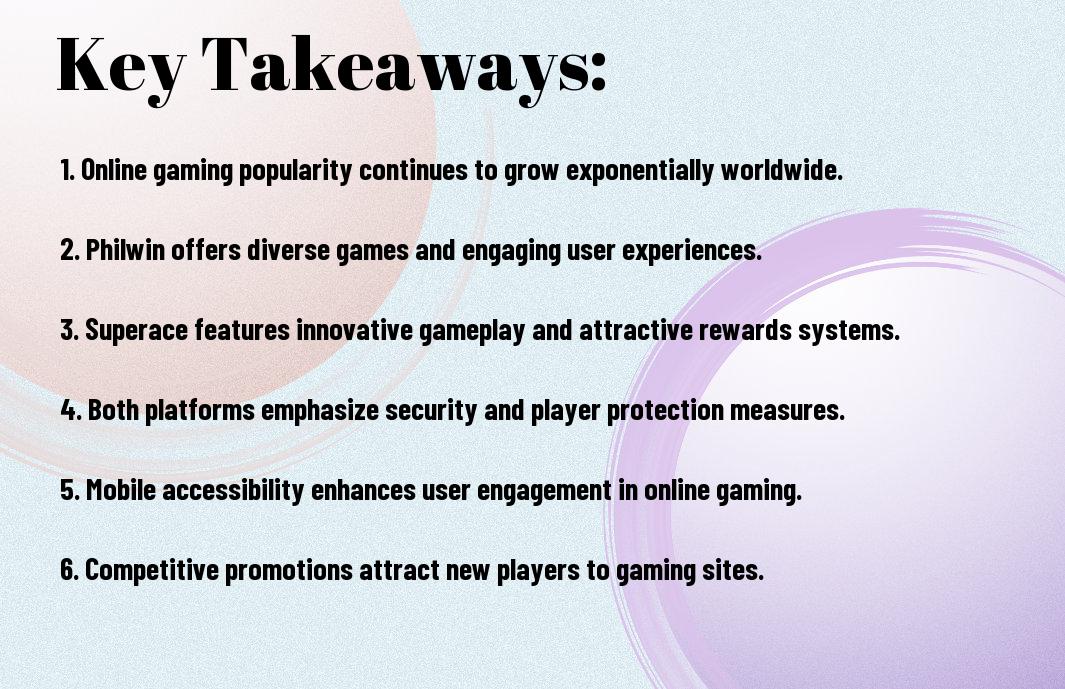There’s an undeniable surge in online gaming that has transformed how we view entertainment and social interaction. As I explore this phenomenon, I will analyze two prominent platforms, Philwin and Superace, which offer unique gaming experiences while raising important concerns about addiction and security. You might be intrigued by the potential for excitement and competition that these platforms provide, but it’s vital to understand the implications for your mental health and financial well-being. Join me as I investigate into the dynamic world of online gaming.
Key Takeaways:
- Growth of Online Gaming: The online gaming industry has experienced significant growth, driven by advances in technology and increased internet accessibility.
- Philwin’s Innovation: Philwin stands out for its innovative gaming options, providing users with unique experiences and engaging gameplay.
- Superace’s Popularity: Superace has gained a massive following due to its user-friendly interface and diverse gaming offerings, appealing to various player demographics.
- Mobile Compatibility: Both Philwin and Superace have optimized their platforms for mobile users, adapting to the rising trend of gaming on smartphones and tablets.
- Community Engagement: The importance of community building is evident as companies like Philwin and Superace focus on fostering player interaction and loyalty through social features and events.

The Evolution of Online Gaming
Historical Background
For me, understanding the historical background of online gaming is crucial in appreciating its current significance and influence in the entertainment industry. Online gaming began in the early 1970s with simple text-based games and developed through the introduction of multiplayer functionalities through the 1980s and 1990s. The launch of ARPANET, the precursor to the internet, allowed players to experiment with a networked gaming experience. It was a thrilling time, as those primitive games hinted at the potentials of what lay ahead, guided by a few innovative minds who dared to dream big.
As we moved into the late 1990s, the advent of the commercial internet opened the floodgates for the online gaming world. Websites emerged, offering players access to a plethora of games that catered to all kinds of interests. Massively Multiplayer Online Games (MMOs) also started to take shape during this era, with games like “Everquest” attracting thousands of players into sprawling virtual landscapes. It was fascinating to see how these games started to create communities, fill social voids, and even contribute to the economic growth of the gaming industry.
The 2000s heralded significant milestones, including the rise of casual gaming, free-to-play models, and the introduction of mobile gaming. Titles like “World of Warcraft” demonstrated how online gaming could transcend traditional entertainment mediums, pulling players into an immersive world unlike any they had experienced before. Through this evolution, the gaming industry underwent a transformation that shifted perceptions of gaming from a niche hobby to a mainstream cultural phenomenon, engaging millions worldwide.
Technological Advancements
Background in technology has always illuminated the foundation upon which online gaming stands. The advancement of internet bandwidth and connectivity undoubtedly played a pivotal role in shaping online gaming. In the past, slow internet speeds and insufficient hardware often limited the quality of online experiences. However, as internet speeds dramatically increased and broadband became more accessible, developers seized the opportunity to innovate and create more complex, high-quality games that entertained and enthralled gamers.
With improved graphics capabilities, we witnessed the rise of engaging visuals and detailed environments, making the experience more immersive. Cloud gaming also emerged as a game-changer, allowing players the ability to play high-end games without the necessity for expensive hardware. The advent of powerful gaming consoles and PCs further expanded the possibilities by offering an enthralling range of gaming experiences that kept players coming back for more.
The integration of mobile technology brought gaming to our fingertips, making it accessible anytime, anywhere. This shift allowed developers to reach different demographics, from casual gamers to hardcore enthusiasts. As we know, mobile platforms have become a massive force in the gaming industry, exemplified by successful titles like “Candy Crush” and “PUBG,” showing just how diverse and expansive the world of online gaming has become.
The effects of the rapid technological evolution in online gaming are profound. It’s not just about the games anymore; it’s about connecting people globally, fostering communities, and creating immersive experiences that break barriers. It’s a testament to human ingenuity that what was once considered a pastime has transformed into a vibrant, thriving ecosystem challenging our perceptions of play.
The Impact of COVID-19
Any discussion around the rise of online gaming today would be incomplete without addressing the impact of the COVID-19 pandemic. As lockdowns and social distancing rules became the norm, millions of individuals turned to online gaming as a means of not only entertainment but also a vital social outlet. It struck me how these virtual spaces became lifelines, allowing friends and families to connect despite being physically apart. During a time of great uncertainty, the gaming community thrived, as players sought solace and camaraderie through shared gaming experiences.
The surge in player engagement during lockdowns led to a significant increase in revenue for gaming companies across the globe. Many developers expanded their offerings with new game releases and updates to cater to the growing numbers of homebound players. This adaptability showcased the industry’s resilience and commitment to evolving according to the changing needs and circumstances of users. With events being canceled, many turned to virtual gaming tournaments, which not only kept spirits high but kept the competitive edge alive in the community.
As a direct result of the pandemic, I also observed a more profound acceptance of gaming among more traditional societal segments. With people of all ages joining in, online gaming shed its past stigma and emerged as a valid form of social engagement and entertainment. The pandemic necessaryly accelerated trends that were already in play, making online gaming a staple of modern life that many wouldn’t have imagined a few years ago.
Historical trends show that the gaming industry has shown a remarkable capacity to adapt and thrive, especially during challenging times. Whether it’s the rise of new genres or the seamless integration of social aspects into gaming, we are living in a time where the power of play has taken on renewed significance and influence.
Major Players in the Online Gaming Industry
Even though the online gaming industry has evolved into a vast ecosystem, several key players stand out due to their significant contributions and influence. These operators and platforms dominate the field, providing the frameworks and technologies upon which millions of gamers thrive. With a variety of investment strategies, product offerings, and innovative user experiences, these companies shape how we engage with online gaming today.
Key Operators and Platforms
An imperative part of the online gaming landscape consists of established operators like Philwin and Superace. Their platforms offer not only a diverse array of games—from traditional slots and card games to immersive live dealer experiences—but also an interface that appeals to both seasoned players and newcomers. These platforms prioritize user experience and security, fulfilling stringent regulatory standards, which instills trust in their gaming environments. As a player, knowing that you are playing on a reputable platform can vastly enhance your experience.
Moreover, it’s important to highlight the technological prowess of these platforms. They use state-of-the-art software and innovative game mechanics to provide an engaging experience. The use of Artificial Intelligence (AI) helps in understanding player behavior, leading to personalized gaming experiences. Such advancements not only improve player engagement but also boost retention rates, making these operators incredibly successful in a highly competitive market. I find it fascinating how technology plays such a critical role in the appeal of online gaming.
Lastly, communication and community building have become vital aspects of online gaming platforms. Companies are increasingly introducing social features, allowing players to interact, share experiences, and form communities. Enhanced by features such as live gaming chats and tournaments, this sense of belonging adds an enticing layer to the gaming experience. So, when you choose an online gaming platform, consider not just the games available but also the community and social aspects that can enrich your gaming endeavors.
Market Share Analysis
Major players in the online gaming industry hold a commanding portion of the market share, which gives them the resources to invest in technological advancements and marketing strategies. For instance, companies like Philwin and Superace have become household names, accumulating loyal customer bases and consistently attracting new players. Unlike traditional gaming, where physical presence is crucial, online gaming enables operators to extend their reach globally, thereby increasing their market share exponentially.
As I analyze market trends, it’s evident that mobile gaming is a key driver for growth. With more people preferring to game on-the-go, platforms have significantly invested in mobile-friendly applications. This strategic pivot has directly influenced their market share, allowing them to tap into demographics that prefer gaming via smartphones. By responding to player needs and preferences, these companies can maintain their competitive edge and solidify their stake in the market.
Plus, emerging trends such as esports integration and the rise of virtual reality gaming are reshaping how we understand market dynamics. As these experiences become more integrated into mainstream gaming, operators that adapt quickly are likely to capture an even larger share. The players that stay ahead of the curve not only benefit financially but also enhance the gaming experience for you, the player, creating endless opportunities for engagement.
Emerging Competitors
One of the fascinating aspects of the online gaming industry is the influx of emerging competitors that are reshaping the landscape. These new entrants often look to disrupt traditional practices by adopting innovative technologies and unique game offerings. For example, several startups are utilizing blockchain technology to offer decentralized gaming experiences, providing players with ownership of in-game assets. This emerging trend is not just exciting; it has the potential to revolutionize how we perceive ownership and value in online games.
Alongside technological advances, these emerging competitors are adept at marketing themselves through social media and influencer partnerships, thereby connecting with younger demographics. This approach has proven effective in generating buzz and excitement around new platforms and games. As a gamer, you may find these platforms appealing not just for their offerings but also for their relatable branding strategies that resonate with you.
Gaming enthusiasts should keep an eye on these newcomers, as they strive to carve out a niche in the ever-expanding online gaming market. By innovating and offering competitive gaming experiences, these emerging competitors will likely push established players to further enhance their platforms and offerings, ultimately benefiting you as a consumer.
Overview of Philwin
To understand the dynamics of the online gaming landscape, one cannot overlook the significance of Philwin, a notable player in this growing sector. In a world where digital experiences have become paramount, Philwin has positioned itself to capture the interest of gamers across various demographics. With its innovative approach and commitment to delivering high-quality gaming experiences, I find Philwin fascinating as it epitomizes the evolution of online gaming.
Company Background
One of the most intriguing aspects of Philwin is its rich company background that charts its journey from inception to its current status. Founded with the vision to create a platform that bridges the gap between entertainment and technology, Philwin has invested heavily in developing unique gaming solutions for its users. The company has rapidly gained traction in the online gaming market by offering an impressive catalogue of games that cater to both casual gamers and serious players. I appreciate how Philwin has leveraged partnerships and technological advancements to ensure it stays ahead of the competition, making it a noteworthy case study in online gaming.
As I probe deeper into Philwin’s history, I learn about its core values, which revolve around user satisfaction, safety, and innovation. The company has prioritized creating a secure environment for players, understanding the potential risks associated with online gaming, such as data privacy and financial security. Additionally, I admire Philwin’s commitment to social responsibility, actively promoting responsible gaming practices and awareness about gaming addiction, which is crucial in today’s fast-paced, digital age.
Interestingly, Philwin has made a mark not only with its games but also through its customer service and community engagement initiatives. This dedication to nurturing a loyal player base is reflected in their proactive support systems and regularly updated communication channels. It’s evident that Philwin understands the importance of community in enhancing user experience, and I find it admirable that they seek to build a more inclusive gaming environment.
Game Offerings and Innovations
Overview of Philwin’s game offerings reveals a diverse portfolio designed to appeal to various gaming preferences. The company has prioritized innovation and interactivity, creating titles that captivate players while also harnessing the latest technology. From classic casino games to modern slot machines and interactive board games, the variety available is staggering and continues to grow. As a gamer myself, I appreciate the effort that Philwin puts into keeping their catalog fresh and relevant to current trends.
To further enhance the gaming experience, Philwin has integrated state-of-the-art technology, such as advanced graphics, immersive soundscapes, and user-friendly interfaces. This not only creates a captivating gaming atmosphere but also ensures that players can navigate through their options seamlessly. I find it fascinating how Philwin utilizes data analytics to track player preferences, allowing them to tailor their offerings and continuously improve their gaming environments. This focus on player-centric innovations is what sets Philwin apart from many other competitors in the space.
To solidify its place in the online gaming community, Philwin is consistently pushing boundaries and exploring new genres and gaming mechanics. By keeping an open ear to user feedback and market trends, they are adept at refining their offerings to better meet the desires of their players. This flexible approach to game development not only enhances user engagement but also ensures that players are always greeted with exciting, new experiences.
User Experience and Engagement Strategies
An imperative component of Philwin’s success lies in its user experience and engagement strategies. I’ve observed that Philwin places a strong emphasis on creating a welcoming and enjoyable environment for its players. From intuitive navigation to visually stunning designs, the platform is built with the player in mind. This attention to detail plays a crucial role in retaining users and ensuring that they return time and again to enjoy their favorite games.
Moreover, Philwin utilizes gamification techniques to enhance engagement, encouraging players to participate more actively in their gaming experiences. This includes implementing reward systems, leaderboards, and bonuses that not only motivate players but also foster a sense of community among them. I find it inspiring how Philwin encourages friendly competition, contributing to a more interactive and enjoyable gaming experience.
The company’s focus on personalized experiences further distinguishes it in the crowded online gaming market. By leveraging user data to provide tailored recommendations and promotions, Philwin ensures that every player feels recognized and valued. This ability to deliver a customized experience is a key factor in enhancing user satisfaction, leading to greater player retention.
The commitment to user experience and engagement really demonstrates Philwin’s understanding of the dynamics in the online gaming ecosystem. With a keen focus on player satisfaction and community engagement, Philwin has successfully established itself as a formidable contender in the online gaming space.

Deep Dive into Superace Options
Now, it’s time to take a closer look at Superace, a formidable player in the online gaming landscape. Superace brings a unique blend of creativity and strategic thinking to its gaming offerings, reflecting a deep understanding of what players desire in an engaging online environment. Established with a clear vision, Superace has steadily climbed the ranks in the world of online gaming, harnessing technology to enhance the user experience and align with industry trends. The company was founded by a team of gaming enthusiasts who recognized a gap in the market—a need for games that not only entertain but also serve to build community among players.
Deep in its ethos is a commitment to innovation and player-centric design. Superace believes in creating immersive experiences that cater not just to the thrill-seekers but also to strategic thinkers. The company’s philosophy revolves around blending entertainment with skill, ensuring that each game is not a mere pastime but a journey that engages players on multiple levels. This approach fosters a loyal community, as players find themselves deeply invested in the gameplay, frequently interacting with one another and sharing strategies. By keeping player feedback at the forefront of their development process, Superace can continuously evolve and adapt its offerings to meet the changing desires of its audience.
As Superace progresses, it remains firmly rooted in its mission to democratize gaming. The team is committed to making its platforms accessible to everyone, regardless of their experience or skill level. They’re always examining how they can break down barriers, allowing both casual and hardcore gamers to enjoy their offerings. Building a sense of belonging is vital to Superace’s identity, as they prioritize creating inclusive spaces where players from different demographics can connect, compete, and thrive.
Unique Features of Superace Games
One of the standout aspects of Superace is the multitude of unique features built into its games that set it apart from competitors. These include innovative gameplay mechanics, captivating graphics, and complex storylines that intertwine to create a rich gaming experience. When you first enter a game created by Superace, you’re welcomed by vibrant visuals that not only grab your attention but also create an inviting atmosphere that encourages prolonged engagement. The team seems to grasp intuitively that aesthetics matter, as they intricately weave narrative elements into the gameplay, making each session feel like a unique adventure rather than just a competition.
With a focus on diversity in gameplay styles, Superace offers something for everyone. Whether you’re interested in fast-paced action, strategy, or role-playing games, their portfolio has carefully crafted options catering to various interests. One defining feature is their ability to incorporate elements of surprise, keeping you guessing and enhancing replayability. The constant updates and seasonal events entice players to return regularly, ensuring boredom is kept at bay. Superace not only practices game development but also excels in community engagement, making players feel valued and invested in the platform’s growth.
In addition to these engaging features, Superace harnesses cutting-edge technology to optimize the gaming experience. It supports multiple devices, ensuring you can play your favorite titles whether you are at home or on the go. This cross-platform compatibility is crucial in today’s gaming environment, where players demand flexibility and accessibility. On top of that, Superace employs robust anti-fraud measures that secure player data and maintain the integrity of the gaming experience.
Player Demographics and Target Audience
An analysis of Superace’s players reveals a diverse range of demographics, catering predominantly to young adults between the ages of 18 and 34. This age group is particularly drawn to the interactive nature of online gaming and seeks both a *social and competitive outlet*. As such, Superace’s games are designed with community-building features and leaderboards, allowing players to engage meaningfully not just within the game but also with each other. It seems to embrace a social aspect that many players crave—the opportunity to connect and compete with friends and fellow gamers around the world.
Furthermore, I have observed that Superace makes a strong effort to attract players from different backgrounds, emphasizing inclusivity in their marketing campaigns. This broad target audience allows Superace to appeal not only to hardcore gamers but also to casual players looking for a quick, entertaining experience. Their assortment of games—from casual puzzle games to intense strategy titles—opens up opportunities for anyone interested in gaming, regardless of their previous experience.
Features like customizable avatars and tailored gameplay experiences further enhance Superace’s appeal. Players appreciate the opportunity to express their individuality through their avatars and game choices, and this personalized approach is instrumental in building loyalty. People want to feel that their gaming experience is uniquely theirs, and Superace caters to this desire effectively.
The Business Models of Online Gaming
After delving into the fascinating world of online gaming, it’s crucial to understand the various business models that have risen alongside this digital revolution. Among these models, two of the most prominent are Freemium and Pay-to-Play. These business strategies have distinct characteristics that cater to different types of gamers, ultimately influencing their gaming experience and financial investment in the titles they choose to engage with.
Freemium vs. Pay-to-Play Models
Any gamer is likely familiar with the Freemium model, where a game is offered for free initially, but players have the option to purchase additional features, characters, or in-game currency. This approach allows developers to attract a vast audience, as it lowers the barrier to entry, inviting players from all walks of life. Once players get invested in the game, they may find themselves tempted by exclusive content that enhances their gameplay experience. While freemium games can generate substantial revenue through in-app purchases, they can also foster frustration if a player feels the need to spend money to compete or enjoy the game fully.
In contrast, the Pay-to-Play model requires players to purchase the game upfront before they can begin playing. This model typically leads to a more polished and premium gaming experience, as developers often allocate their resources toward creating quality content rather than continually upselling through microtransactions. Players generally know what they are getting into from the outset, which might deter some but can also attract those willing to invest in a comprehensive gaming experience. The challenge, however, lies in shedding light on the value proposition of these games, especially when there are numerous free alternatives available.
In light of these models, it’s evident that both have their merits and downsides. As a gamer, you may prefer one model over the other based on your personal gaming style and financial perspective. I find it fascinating how these models impact the overall player engagement and community dynamics, creating a lively discussion around the future of gaming monetization.
Subscription-Based Services
On the other hand, subscription-based services have entered the scene as a formidable competitor to the aforementioned models. With platforms offering a library of games at a fixed monthly fee, players can explore a diverse range of titles without making a significant financial commitment. This model aligns with the value-driven preferences of many gamers who wish to experiment with different games without the pressure of purchasing each title individually. You might appreciate the idea of having unlimited access to a plethora of gaming options, making it easier to discover hidden gems or revisit classics.
The appeal of subscription services lies in their potential for consistent revenue generation for developers, who can maintain a steady influx of income from subscribers. Additionally, this model often leads to enhanced player engagement as a variety of games prompts players to explore beyond their usual preferences. However, the challenge for subscription services is ensuring that they continue to attract and retain players by updating their game libraries regularly and providing quality content. If the offerings become stale or fail to appeal to the subscriber base, retention rates may drop significantly.
This model can also foster a sense of community among subscribers, as players can easily share their experiences with a current library that encompasses both popular and niche titles. As a player, it might be worth considering if a subscription service aligns with your gaming habits and how often you play, as these services may not offer the best value if you’re only an occasional gamer.
In-Game Purchases and Monetization Strategies
Online gaming is also heavily influenced by in-game purchases and various monetization strategies. This approach has become incredibly popular, especially in games that follow the freemium model. Players can choose to buy aesthetic elements such as skins, costumes, or even exclusive characters, which enhances their overall gaming experience. However, this model can be particularly challenging for players who wish to experience a more level playing field, as those with disposable income may have an unfair advantage.
The motivations behind in-game purchases range from player engagement to advanced monetization techniques, leading developers to create content that encourages players to spend. By incorporating limited-time offers, exclusive content, or seasonal events, developers can effectively stimulate demand for in-game purchases. I’ve often observed how this strategy not only increases revenue but can also create a sense of urgency among players to secure unique attributes, driving a cycle of continued spending.
Strategies for monetization in online gaming inherently present several opportunities and risks. While the influx of revenue can pave the way for developers to deliver improved content and game updates, there is also the danger of alienating players who feel pressured into spending to achieve their desired experience. As a player, I find it critical to strike a balance between enjoying the الألعاب while being mindful of my spending behavior.
Strategies related to in-game purchases are varied and continually transforming, requiring developers to remain attuned to player sentiments and market trends. I believe that as you navigate the online gaming landscape, being aware of these strategies will help you make informed decisions and enhance your overall gaming experience.
Regulatory Environment
All aspects of the online gaming industry are significantly influenced by the regulatory environment that governs them. From licensing to compliance, regulations can have a profound impact on operations and user experiences. I find it particularly important to understand how legal frameworks affect platforms like Philwin and Superace, as they navigate a tangled web of laws and regulations unique to their regions. The online gaming landscape does not merely involve spinning the reels or placing bets; it’s equally about ensuring that the activities of these platforms are legally sound, transparent, and secure.
Licensing and Compliance Issues
One of the most critical aspects of the regulatory environment for online gaming operators like Philwin and Superace is the licensing and compliance issues. If a platform does not hold the appropriate licenses, not only will it face legal repercussions, but it will also lose the trust of its user base. I believe that compliance with local regulations persuades users to engage more confidently with these services. Furthermore, obtaining a license is a rigorous process that often requires extensive documentation, background checks, and continuous audits to ensure that operators adhere to strict ethical and operational guidelines. This serves to protect consumers and maintain the integrity of the gaming ecosystem.
In addition, I have come to realize that the compliance landscape is not static; it continually evolves in response to technological advances and shifts in public sentiment. For example, many jurisdictions are starting to recognize the benefits of regulated online gaming in terms of tax revenue and consumer protection. This creates avenues for platforms to innovate while still adhering to strict guidelines. Operators must not only be flexible but also proactive in securing and maintaining their licenses, often requiring dedicated compliance teams who monitor changing laws and implement necessary changes in real time.
Lastly, for me, the importance of transparent communication regarding licensing cannot be overstated. Operating in jurisdictions where licenses are authenticated reassures players about the fairness of the games and the security of their personal information. More consumers are becoming educated about the potential risks associated with unlicensed platforms, which puts a pressure on operators like Philwin and Superace to prioritize compliance and demonstrate that they operate within the bounds of the law. Failing to do so could lead to disastrous consequences, not only financially but also in terms of reputation.
Gambling Laws and Online Gaming
An vital element in discussing the regulatory environment is understanding gambling laws and their direct implications on online gaming. I find it critical to acknowledge that rules vary significantly by jurisdiction. While some regions embrace online gaming, others may impose strict limitations or even bans outright. This patchwork of laws influences how platforms operate and how they market their services. For example, companies such as Philwin may have to adopt a cautious approach when advertising or promoting their offerings to potential customers in areas with stringent regulations. Additionally, users may be limited in their ability to deposit or withdraw funds based on regional laws.
Moreover, the dichotomy between conservative policies and expanding markets often leads to complex legal disputes. I appreciate the balance that needs to be struck between encouraging economic growth and ensuring ethical standards are met. Issues such as age restrictions, problem gambling protections, and fairness in gaming must be critically evaluated to minimize harm and maximize benefits. As a consumer, you must stay informed about the laws that govern your gaming experience to ensure you engage with trustworthy platforms.
A significant part of online gaming legalities revolves around consumer protection laws, which are designed to safeguard players from unfair practices. This includes clarity about the odds of winning, responsible gaming measures to prevent addiction, and protection of personal data. I find that understanding these laws not only bolsters your confidence in engaging with platforms like Philwin and Superace, but also empowers you to make more informed decisions about your online gaming activities.
Future Trends in Regulation
Environmentally, the future trends in regulation for online gaming platforms may shape a new landscape for operators and consumers alike. As technology advances, it’s evident that jurisdictions will adapt their laws to address the growing popularity of online gaming and the diverse demographics of players. I see a continuing shift towards a more comprehensive regulatory framework that incorporates considerations for new technologies such as blockchain and cryptocurrencies, which can offer unprecedented levels of transparency and security. Some regulatory bodies are beginning to realize the potential benefits of these technologies for monitoring transactions and protecting consumers.
Additionally, a significant trend I foresee is the increased focus on player welfare and responsible gaming. As awareness of gambling addiction rises, more countries are likely to implement stringent requirements for operators to demonstrate their commitment to responsible gaming practices. You may see platforms compelled to incorporate advanced features such as self-exclusion tools, spending limits, and easy access to support resources. This is not only a way to protect the players but also a compelling selling point for operators looking to build a trustworthy brand.
In summarization, the regulatory environment surrounding online gaming is entering a phase of transformation. Laws regarding online gaming will likely evolve to address new technologies and stronger consumer protection measures, ultimately fostering a safer gaming atmosphere for all stakeholders involved. As an informed consumer, you should remain aware of these trends to not only protect your rights but to also seize opportunities for a more rewarding gaming experience.
Laws in the future will undoubtedly reflect the ongoing dialogue between operators, lawmakers, and consumers. Maintaining a proactive approach to regulation will be vital, especially for platforms like Philwin and Superace, as they will need to adapt to these changes. As the online gaming industry grows, stakeholders must prioritize collaboration to ensure an equitable and responsible environment for all involved.
Conclusion
Upon reflecting on the rise of online gaming, particularly in the context of platforms like Philwin and Superace, I can see a significant shift in how we engage with digital entertainment. The evolution of technology and the accessibility of high-speed internet have democratized gaming, making it available to a wider audience than ever before. You might have noticed that gaming is no longer confined to age or demographic; it transcends boundaries, creating a community where seasoned gamers and newcomers alike can interact and share their experiences. This has resulted in not just a boom in user numbers but also a diversification in gaming styles and genres, catering to different preferences and tastes. Understanding platforms like Philwin and Superace allows you to appreciate the innovative features they bring to the table, such as user-friendly interfaces, secure payment options, and engaging gameplay mechanics that enhance your gaming experience dramatically.
Both Philwin and Superace have established themselves as key players in the online gaming landscape, each offering unique advantages that cater to different segments of the gaming population. As I research deeper into their functionalities and offerings, I recognize how they effectively harness technology to create immersive gaming environments. Philwin, with its focus on user engagement and community-building, showcases features that encourage social interaction among players, where you can easily partake in tournaments and collaborate with fellow gamers. On the other hand, Superace emphasizes quality graphics and a rich narrative experience, appealing to those looking for storytelling and thematic depth in their gaming sessions. By choosing either platform, you are not just opting for entertainment but investing in a comprehensive gaming experience that adheres to your individual preferences and desires.
Ultimately, the ascent of online gaming platforms reflecting the dynamism of our digital society speaks volumes about how we seek communal and engaging experiences today. I encourage you to explore these platforms further, not only to enjoy the gaming experience they offer but also to engage with a community that shares your passion. As we journey into a future shaped by technology, it’s important to stay attuned to these developments as they can richly enhance your leisure time. The world of online gaming is continuously evolving, and understanding platforms like Philwin and Superace will empower you to make informed choices that align with your gaming interests and foster enjoyable interactions in this vibrant digital space.
FAQ
Q: What are Philwin and Superace options in the context of online gaming?
A: Philwin and Superace are two popular online gaming platforms that offer various gaming options like slots, table games, and sports betting. They cater to different player preferences and provide unique features, bonuses, and experiences that enhance the online gaming experience. These platforms have gained popularity due to their user-friendly interfaces and a wide range of games.
Q: How has the rise of online gaming impacted traditional gambling?
A: The rise of online gaming has significantly transformed the landscape of traditional gambling. Many players are now opting for the convenience of online platforms like Philwin and Superace, which allow them to play from the comfort of their homes. This shift has prompted traditional casinos to adopt online elements, expand their digital presence, and offer hybrid gaming options to compete. Moreover, the online realm attracts a younger audience, creating a need for traditional establishments to adapt and innovate to retain their customer base.
Q: What security measures do Philwin and Superace implement to ensure safe gaming?
A: Both Philwin and Superace prioritize user security by employing advanced encryption technologies and secure payment gateways to protect players’ personal and financial information. They also implement strict verification processes and adhere to regulatory standards to ensure fair play. Additionally, these platforms promote responsible gaming practices and offer options to set limits on deposits, losses, and gaming duration to safeguard the well-being of their users.
Q: Are there special promotions or bonuses available on Philwin and Superace?
A: Yes, both Philwin and Superace regularly offer various promotions and bonuses to attract and retain players. These may include welcome bonuses for new users, free spins, cashback offers, and loyalty rewards for ongoing players. It’s important for users to check the promotional section of each platform for the latest offerings and terms associated with these bonuses to maximize their gaming experience.
Q: How do Philwin and Superace compare in terms of game variety and user experience?
A: Philwin and Superace both boast a rich variety of games that cater to different tastes, including slots, live dealer games, poker, and sports betting. However, the user experience can vary, with each platform exhibiting distinct features such as layout design, loading speed, and mobile compatibility. Players may find one platform more appealing due to its interface or specific game offerings. Reviews and user feedback can be helpful in determining which platform aligns better with personal preferences, as frequent game updates and new releases are also common in both platforms.





